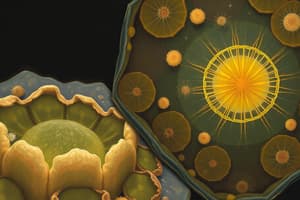Podcast
Questions and Answers
Which of the following statements is NOT part of the cell theory?
Which of the following statements is NOT part of the cell theory?
- Cells are the smallest unit of life.
- All living things are made of cells.
- All cells come from pre-existing cells.
- All cells contain a nucleus. (correct)
Ribosomes are responsible for making proteins in both prokaryotic and eukaryotic cells.
Ribosomes are responsible for making proteins in both prokaryotic and eukaryotic cells.
True (A)
Who discovered that all cells come from other cells?
Who discovered that all cells come from other cells?
Rudolph Virchow
The ________ is the jelly-like substance that surrounds organelles in a cell.
The ________ is the jelly-like substance that surrounds organelles in a cell.
Match each organelle with its function:
Match each organelle with its function:
What defines a prokaryotic cell?
What defines a prokaryotic cell?
Chloroplasts are found in both plant and animal cells.
Chloroplasts are found in both plant and animal cells.
Name one organelle that is present in prokaryotic cells and eukaryotic cells.
Name one organelle that is present in prokaryotic cells and eukaryotic cells.
Flashcards
What is cell theory?
What is cell theory?
The theory that all living things are made of cells, the cell is the smallest unit of life, and all cells come from pre-existing cells.
What is a prokaryotic cell?
What is a prokaryotic cell?
A cell that does not have a membrane-bound nucleus and lacks most other membrane-bound organelles.
What is cytoplasm?
What is cytoplasm?
A jelly-like substance that fills the cell and surrounds the organelles.
What is a nucleus?
What is a nucleus?
Signup and view all the flashcards
What is the nucleolus?
What is the nucleolus?
Signup and view all the flashcards
What is the endoplasmic reticulum (ER)?
What is the endoplasmic reticulum (ER)?
Signup and view all the flashcards
What are Golgi bodies?
What are Golgi bodies?
Signup and view all the flashcards
What are chloroplasts?
What are chloroplasts?
Signup and view all the flashcards
Study Notes
Cell Theory
- Cells were not studied until microscopes were invented.
- Zacharias Janssen made the first microscope.
- Robert Hooke looked at cork and called the particles cells.
- Anton van Leeuwenhoek found microscopic organisms ("animalcules").
- Matthias Schleiden discovered cells in plants.
- Theodore Schwann discovered that all animals are made of cells.
- Rudolph Virchow discovered that all cells come from other cells.
- Cell theory:
- All living things are made of cells.
- The cell is the smallest unit of life.
- All cells come from pre-existing cells.
Prokaryotic Cells
- Prokaryotic cells are cells that do not have a nucleus or other membrane-bound organelles.
- Examples are bacteria.
- Characteristics:
- Organelles not surrounded by membranes
- Lack a nucleus
- Organelle functions:
- Slime Capsule: protects the cell from physical or chemical attacks.
- Cell Wall: surrounds the cell membrane and protects.
- Cell Membrane: separates the inside from the outside; semi-permeable.
- Cytoplasm: jelly-like substance surrounding organelles.
- Nucleoid: irregularly shaped region containing DNA
- Plasmid: small circular DNA molecule
- Ribosomes: make proteins
- Pili: surface organelles (hair-like) aid in mobility.
- Flagella: thread-like (tail) helps in movement.
Eukaryotic Cells
- Eukaryotic cells are cells that contain a membrane-bound nucleus and membrane-bound organelles.
- Organelles:
- Flagella/Flagellum: movement
- Cilia: movement
- Cell Wall: structural support and protection (plants, fungi, algae)
- Cell Membrane: regulates what enters and exits the cell
- Cytoplasm: semi-fluid substance filling the cell
- Nucleolus: produces ribosomal subunits
- Nucleus: stores DNA (control centre)
- Ribosomes: make proteins
- Rough ER: channels for transport of proteins (ribosomes attached)
- Smooth ER: channels for transport (no ribosomes)
- Golgi Bodies: packages proteins into vesicles
- Vesicles: carry materials in/out of the cell
- Vacuoles: store water/nutrients (large in plant cells)
- Lysosomes: break down organelles/waste
- Chloroplasts: only in plant cells, contain chlorophyll for photosynthesis
- Mitochondria: powerhouse of the cell, produces energy
- Centrioles: help with cell division
- Cytoskeleton: provides structure and support
Shared Organelles and Functions
- Ribosomes, cell walls, cell membranes, cytoplasm, and flagella are in both prokaryotic and eukaryotic cells.
- However, the functions of these organelles may vary between the types of cells.
Additional Concepts
- Muscle cells need more mitochondria because they require more energy to move.
- Sugar produced by photosynthesis goes to mitochondria to create energy.
- The cell membrane is semi-permeable to control what goes in and out of the cell.
- Plant vacuoles are larger than animal vacuoles due to the plant's need for water for photosynthesis.
- Each cell generally has only one nucleus due to a single set of DNA and one control centre.
Studying That Suits You
Use AI to generate personalized quizzes and flashcards to suit your learning preferences.




